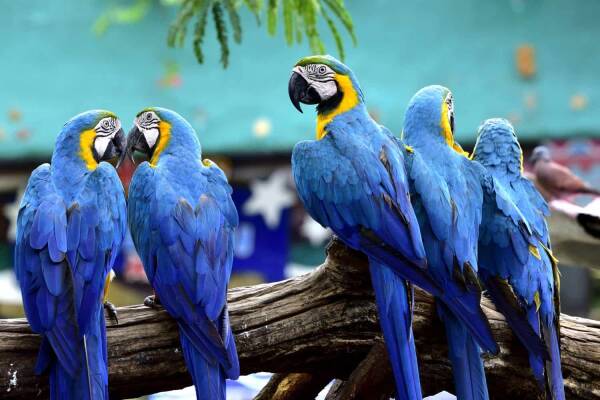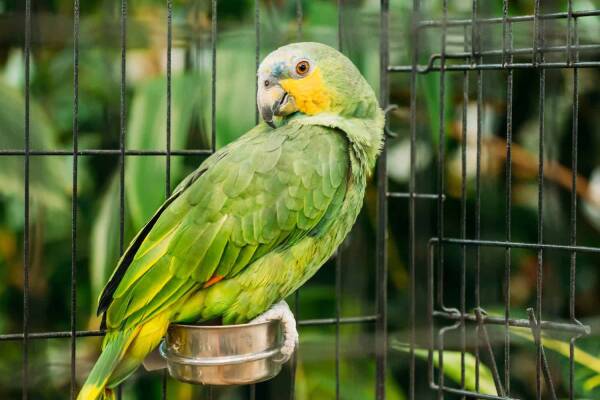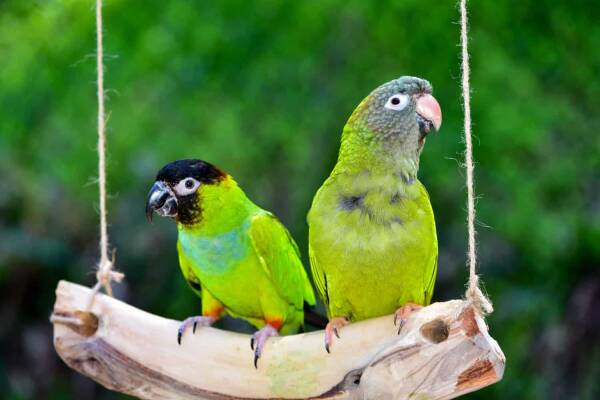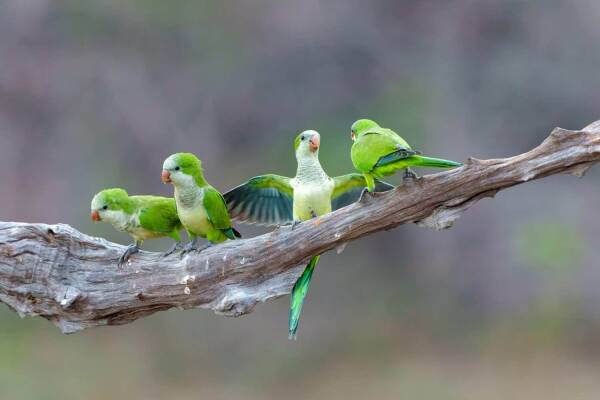With year-round sunshine, white sand beaches, and vibrant wildlife, Florida is unlike anywhere else in the United States. This southern state is considered the land of eternal summer, providing the perfect environment for a variety of bird species, especially tropical parrot species. Across the state's vast terrain, there are a few species that stand out from all the others. The five most common parrots in Florida come from all over the world. Known for their playful movements and graceful calls, these colorful and charismatic birds successfully capture the attention of locals and tourists alike. Even though they only make up a small percentage of Florida's bird species, that makes them even more special! Read on to learn everything you need to know about the 5 most common species of parrots in Florida.
Why Florida is the Best Place for Parrots
First, before we dive into the fascinating world of Florida parrots, let’s explore why the state’s unique ecological wonderland is so perfect for them. Nestled in the southeastern corner of the United States is the peninsula that makes up the state of Florida. It has an array of stunning natural features. There is no doubt that this state has a treasure trove of natural beauty. From the famous Florida Everglades, with its vast marshes and mysterious cypress swamps, to Myakka River State Park, where acres of land are filled with trees, trails, and native wildlife, Florida is home to a variety of An environment where a variety of birds thrive. That said, let’s embark on a journey into the fascinating world of Florida parrots.
None of Florida's wild parrots are native to the state. Virtually every tropical bird found in the state has been introduced as a pet or brought into bird exhibits for use. From their interesting markings and unique behaviors to their critical role in Florida’s ecosystem, these feathered residents have stories to tell!
What is the difference between a parrot and a parakeet?
Parrots and parakeets are both members of the order Psittaciformes. While this is true, parrots and parakeets are actually two completely different species. Generally speaking, parrots are larger than parakeets, with the average size ranging from 3 to 40 inches. They come in many different colors, the most common being bright green. You can also often find parrots with red, yellow, or blue feathers. Parakeets, on the other hand, are usually no longer than 18 inches in length (measured from the top of their head to the tip of their tail). Parakeets also come in green, but many are combinations of blue and white, green and yellow, or various grays. Parrots are sturdier, partly due to their larger size. Another useful addition is their powerful beaks. In comparison, parakeets have a more slender, docile frame and beak.
Another significant difference between parrots and parakeets is their overall intelligence. Parrots are generally easier to train than parakeets. Some experts believe this is because they have higher IQs. That being said, both parrots and parakeets have a well-developed ability to imitate sounds, sounds, and even human speech patterns. Although these two birds are technically different species, we will cover them in this article. That’s because, while there are lots of parrots in the Sunshine State, there are just as many parakeets!
5. Blue and Gold Macaw

Blue and golden macaws typically live 35 to 40 years in the wild. They survive on nuts, seeds, fruits, and other plant material.
Amazingly, Florida is home to more than 20 wild blue and gold macaws ( Ara ararauna ). They are found throughout Central and South America, primarily in Panama, Venezuela, Bolivia, Colombia, Paraguay and Peru. This species prefers tropical forests, woodlands, and savannas. Although not widespread or common, it is possible to spot this species soaring in the skies near Coral Gables, Pinecrest, and Palm Bay. They have lived in Florida since the mid-1980s. It's important to note that this species is not native to Florida or any other area in the United States. Instead, these macaws came to Florida as escapees from animal exhibits, quarantine facilities and private collections.
This species is easy to identify in the wild because it is unlike any other bird in the state. Blue and gold macaws can be identified by their vibrant cobalt blue outer feathers and golden yellow underparts. Blue and gold macaws typically have white faces with black patches on their throats. Their bodies are also much larger than other parrots. They range in size, up to 35 inches long and with a wingspan up to 45 inches wide. A distinctive feature is their long, fan-shaped tail. Both sexes look identical, but the female's head is noticeably smaller and more slender.
4. Orange-winged Parrot

Orange-winged parrots are naturally charismatic, funny and talkative. Their comedic personalities make this bird an ideal species to keep as pets.
Found mainly in Miami and Fort Lauderdale, the Orange-winged Parrot is another common bird in Florida. Also known as Loro Guaro, they are native to northern South America, Guyana, Brazil, Trinidad and Tobago. The species thrives in the tropics, inhabiting forests, mangrove swamps, and grasslands. Florida's orange-winged parrot population is found primarily in city parks and near beaches. The most common sighting locations are in and around Matheson Hammock, Brewer Park, Pompano Beach, and Miami Springs.
If you want to spot an Orange-winged Parrot, there are a few key characteristics you can look for. Although most of their bodies are covered in bright green feathers, one of their most obvious signs is their wings. As the name suggests, orange-winged parrots have distinctive bright orange and red spots on their wings. These unique markings can sometimes be seen when the birds are perched, but most often they are only visible when in flight.
In addition to their wings, the feathers under their tails are also orange. Typically, the rest of their tail feathers are green with a yellowish tip. Additionally, these birds have a light blue mask, yellow crown, and bright yellow cheek markings. Orange-winged parrots are medium-sized birds, with an average length of 13 inches from the top of the head to the tip of the tail. Like other parrots, they can live to be over 50 years old!
3. Red-crowned Amazon Parrot

One sure way to tell the difference between a bird's emotions is to look at their eyes. Since their pupils dilate and constrict easily, you can easily identify if they are anxious, excited, interested, aggressive, or fearful.
Another common parrot in Florida is the red-crowned Amazon (Amazona viridigenalis), also known as the green-cheeked Amazon or Mexican red-headed parrot. The birds, native to Mexico and other parts of Central America, arrived in Florida due to problems with an alleged smuggling operation. Today, they are one of the most endangered parrot species. The number of wild red-crowned Amazon parrots in Florida actually exceeds the number in their home state.
High levels of exploitation for the caged bird trade and long-term loss of habitat are two of the main reasons for this species' rapid decline in the wild. It is estimated that more than 400 of these birds live in Florida, most commonly found in cities in the southeastern part of the state. While the number may seem small, experts welcome the increase as there are currently only a few thousand in the wild.
How to identify a red-crowned Amazon parrot?
Red-crowned Amazon parrots are often described as stocky or stocky, can grow up to 12 inches in length, and weigh an average of 11 ounces. Their wingspan is about 25 inches. The characteristic blue rings around the eyes and striking red crown are key identifying marks of this bird. Additionally, their iris colors range from bright yellow to deep red. Gray eyes indicate that the bird is still young, as the iris color changes as it matures. Males usually have more red than females, and females have red between their eyes instead of blue.
Red-crowned Amazons also have red and blue feathers on their wings and a yellow band at the end of their tail. They have a distinctive call and are notorious for making a lot of noise in the early morning and evening hours. This bird is known for its unique explosive call, often heard whistling, squeaking or screeching. While some people are good at talking and imitating sounds, they are best at imitating sounds that stand out to them, such as car horns, the sounds of other animals, and even telephones!
2. Nandi Parrot / Black-crested Parrot

Black-crested parrots are popular in bird exhibitions due to their high intelligence. They are preferred over other birds because they can quickly learn new tricks and vocalizations.
The second most common parrot in Florida is the Nanday parakeet (Aratha nenday), also known as the black-crested parakeet (Nandayus nenday). This species is not native to Florida. Instead, in 1959, a group of them were released from a pet shop and became wild for the first time. Today, they can be found across the state from the Florida Keys to as far north as Jacksonville. With a growing population of approximately 1,000 birds, this beautiful species has established larger populations in Miami and throughout Tampa Bay, especially in St. Petersburg.
Recognizable by its black "hooded" head and dark beak, the Nandi parakeet takes its name from a South American native, has a mostly green body, and thigh feathers. It's bright red. Some of these birds also have blue highlights on their wings and tails. At approximately 12 inches long and weighing only 4.9 ounces, these parakeets are considered medium-sized. Males can sometimes be distinguished from females due to their larger size. Apart from this, there are no other common differences between men and women. The hood markings on their heads and beaks are also typically bolder than their female counterparts. Nandi parakeets also have a very unique call that manifests as a loud, repetitive screech. When they perch, they emit a harsh, discordant chirp. They are known for their high-pitched calls while flying.
1. Monk Parrot/Quaker Parrot

Quaker parrots reach sexual maturity at two to three years of age and are eventually paired with another individual. They are monogamous birds, usually mating and raising chicks with only one partner throughout their lives.
The monk parrot (Myiopsitta monachus) is the most common parrot in Florida. This species has many aliases, including monk parrot, quaker parrot or quaker parrot. Although this species primarily lives in parts of Miami, West Palm Beach, and Tampa, they can be found in all areas of Florida. Known for their quirky personalities, monk parrots originate from South America and thrive in temperate to subtropical regions. Their average life span is 20 to 30 years. They can reach 11 to 13 inches in length, measured from their head to the tip of their long, tapered tail. Women tend to be around 10-20% smaller than men, but this is not always an accurate measurement.
How to identify a monk parrot?
To spot monk parrots, look for their bright green little bodies as they dart across the sky. In flight, the primary flight feathers and outer secondary flight feathers are visible. The wings of most monk parrots are blue, which is another identifying factor to look for when identifying this bird. In addition to their vibrant exterior color, they have a soft yellow-green belly, a prominent gray face, and a subtle gray-yellow breast area. Their beaks are pale in color with a slight pink or orange flush. Their legs are gray. If you find yourself in close contact with this bird, brown eyes are the most common for this species.
Monk parrot calls (and other identifying factors)
Additionally, they are very vocal birds. When they are perched or in their nest, they make a short, chatty sound.A unique call composed of symbols. When they fly, they make louder calls. If kept in captivity or raised, monk parrots can learn to mimic human speech patterns. Additionally, a key characteristic of monk parrots is that they build nests large enough to house a colony of 20-30 monk parrots. They are the only parrot species that build their own nests, so if you see a giant nest while traveling in Florida, be aware that there must be a flock of these birds nearby!
Finally
All in all, Florida is a tropical paradise perfect for a variety of parrot species. This article lists the 5 most common parrot species in Florida. We also explore how to accurately identify each bird species and examine where they came from and where they can be found in the state today. From the vibrant plumage of the striking monk parrot to the quirky personality of the Nandi parakeet, these feathered residents bring an explosion of color and beauty to the state. That being said, while these parrot species do bring tropical wonders to Florida, these non-native birds also have an impact on the environment and other native species.
Negative impacts of non-native tropical birds on Florida ecosystems
Non-native parrots have both positive and negative impacts on Florida’s ecosystem. First, the large presence of these tropical birds may disrupt the balance between local animals and the environment. It is common for native and nonnative birds to compete for food, nesting sites, and other important resources. This competition can put additional pressure on vulnerable native species, potentially leading to population declines. Additionally, non-native species may introduce new diseases into areas where native species cannot cope. This further jeopardizes the health, well-being and overall chances of survival of native species.
By understanding the impact of non-native parrots on the state's environment and other bird species, we can work to find a balance that allows both groups to coexist harmoniously. So if you’re in the Sunshine State, bring your binoculars with you to fully appreciate Florida’s wide variety of tropical parrots!
animal tags: Parrot
We created this article in conjunction with AI technology, then made sure it was fact-checked and edited by a Animals Top editor.